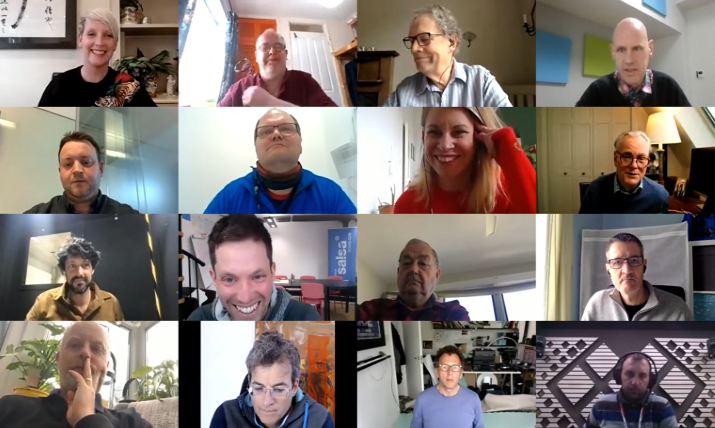Inaugural SVG Europe Sound Talks – Mixing Broadcast Sound spectacular success
Mixing Broadcast Sound goes with a bang

Speakers at the first Sound Talks – Mixing Broadcast Sound felt that many of the adjustments and new working practices that had been accelerated by the pandemic would stay around even post-COVID
The inaugural SVG Europe Sound Talks event of 2021, Mixing Broadcast Sound, was a spectacular success, with nearly 100 participants present for the panels and Q&A sessions. In all respects, the calibre and number of participants, and the range of topics and debate, surpassed SVG Europe expectations.
In the first session, Thought Leaders Perspectives, Roger Charlesworth spoke with Henry Goodman, director of product development at broadcast console manufacturer Calrec Audio, and Rob Oldfield, co-founder and CEO at Salsa Sound, developers of artificial intelligence (AI)-driven automatic audio mixing tools for sports broadcast. The trio addressed the challenges of console virtualisation and remote working in live sports broadcasting from the toolmaker’s point of view.
Catalysts for change
An early part of this discussion was centred around catalysts for change in technologies and the idea that this was not a simple matter of COVID causing a move to remote working. It was agreed that the causes were more complicated and had actually been in play since well before the pandemic, with IP connectivity being a big factor, along with both logistic and creative motivations. However, it was also clear that the pandemic had been an ‘accelerating’ feature.
The session looked at several hub models that were in play for various broadcasters and varying tiers of sports production, including remote full audio transport or monitoring only with remote DSP, and even the possibility of distributed processing power from single DSP cores and how that feeds into the notion of processing becoming a cloud-based software service in the future.
Indeed, it was put forward that a move to cloud in the future was inevitable, though the challenges to audio manufacturers are substantial. However, the potential for streamlining services with multiple feeds in many formats, languages, viewer perspectives and so on is huge.
Trend towards remote working
The second session, Audio Insider Perspectives, was chaired by Alex Judd, technical specialist at Sky Sports, with contributions from A1 sound supervisor and audio guarantee Pete Mercer, A1 sound supervisor Emma Penny from Sky Sports, A1 broadcast sound engineer Alessandro Sdrigotti from NVP, deputy head of sound from NEP UK, Neville Hooper, and A1 sound supervisor Ian Rosam.
Up for discussion was today’s workflows for live football, and again this centred particularly around the trend towards remote working and the challenges that had been presented by the COVID pandemic.
The idea that remote working was already being rolled out across many sports and projects before any COVID influence was reiterated by the group, with several examples, such as Sky Sports’ Formula E and European Football League coverage. In fact, coverage of the broadcaster’s latest addition – Extreme E, the international off-road racing series – was a ground-up remote production from NEP UK based at a new purpose-built remote production facility in central London.
Audio transport solution
A number of new working practices for remote operations were discussed, including audio transport solutions and increased complexity in off-site connection, such as the need for many new additional comms lines and transport of individual pre-fade channels from site, which in turn required new managed media transport solutions. Other ‘adjustments’ including managing comms and IFB, particularly when it comes to onsite talent, who may well be feeling a lot more isolated with vastly reduced crew on site.
The challenges of virtual crowd noise were discussed, with interesting differences noted in approach by broadcasters and varying levels of acceptance in domestic markets, with some preferring no crowd noise, which brings new field-of-play mixing challenges, and others building their mixes from virtual crowd upwards.
In general, the participants felt that many of the adjustments and new working practices that had been accelerated by the pandemic would stay around even post-COVID. That fact many had already made the move to immersive content, with much of that mixed remotely anyway, and given other benefits such as environment gains, transport costs, time efficiencies and more, it was certain that remote production was a new fact of modern sports broadcasting and that maybe the remaining days for large onsite trucks and logistics were already being counted down.
The session ended with a Q&A segment with all panel members taking part. Questions ranged from the problems of mic positioning and confidence for remote operators, network audio transport protocols and efforts to standardise control protocols through the NMOS standard.
SVG Europe audio editor Paul Mac concluded the session, noting that creativity seemed to be at the heart of what broadcasters were up to at the moment, whether that was in pushing craft, or finding technological solutions, and that much that was pioneered to see us through the recent world health crisis would undoubtedly be shaping the future of broadcasting.
Many thanks to all participants, hosts and SVG Europe sponsors Telos Alliance and TSL Products, for making the event such a fantastic success.
